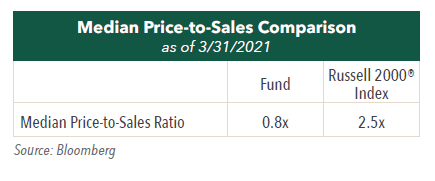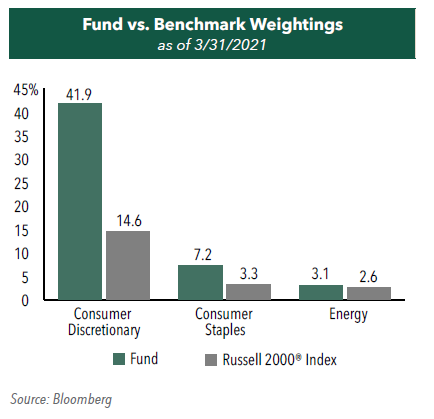Seeking Outperformance through Value and Momentum
In the following commentary, the Portfolio Managers of the Hennessy Cornerstone Growth Fund discuss the Fund’s formula-based investment strategy and how it drives the Fund’s sector and industry positioning.
-
 Neil J. HennessyChief Market Strategist and Portfolio Manager
Neil J. HennessyChief Market Strategist and Portfolio Manager -
 Ryan C. Kelley, CFAChief Investment Officer and Portfolio Manager
Ryan C. Kelley, CFAChief Investment Officer and Portfolio Manager -
 L. Joshua Wein, CAIAPortfolio Manager
L. Joshua Wein, CAIAPortfolio Manager
What is the Hennessy Cornerstone Growth Fund’s investment strategy?
The Fund utilizes a formula-based approach to build a portfolio of attractively valued, growth stocks whose stock prices are exhibiting strong relative strength. In essence, the strategy seeks to combine elements of both value and momentum investing. From the universe of stocks in the S&P Capital IQ Database, the Fund selects the 50 stocks with the highest one-year price appreciation that also meet the following criteria:
» Market capitalization exceeding $175 million
» Price-to-sales ratio below 1.5
» Annual earnings higher than the previous year
» Positive stock price appreciation over the past three- and six-month periods
Why does the Fund use these screening criteria?
The Fund uses a sales-based value criterion because sales are more difficult to manipulate than earnings. The price-to-sales ratio works well under almost all conditions, including when a company’s profitability may be temporarily depressed or when earnings may be artificially inflated.
Higher year-over-year earnings helps identify growth stocks, i.e. companies that are operating successfully in growth markets, gaining market share, or increasing their profitability.
Positive price appreciation over three- and six-month periods generally reflects market recognition of improving underlying fundamentals in the near term.

Why does the formula select stocks with the highest one-year price appreciation?
From among the companies that meet the screening criteria, the Fund selects the 50 with the highest one-year price appreciation. We believe this ranking by relative share price strength can be a good predictor of future price appreciation, or outperformance.
How does the Fund seek to provide a return to investors?
We believe the Fund’s investments present the potential for capital appreciation as a result of earnings growth and potentially higher valuations.
How often does the Fund rebalance its portfolio?
The universe of stocks is re-screened and the portfolio is rebalanced annually, generally in the winter. Holdings are weighted equally by dollar amount with 2% of the Fund’s assets invested in each.
How does the Fund’s portfolio differ from its benchmark?
Compared to its benchmark, the Russell 2000® Index, the Fund has a substantial overweight position in consumer stocks, with roughly 50% of the Fund invested in the Consumer Discretionary and Consumer Staples sectors. Automotive dealers, discount retail, and outdoor recreation-related consumer companies account for a large portion of the Fund’s holdings in the consumer area. While consumer spending contracted in 2020 due to pandemic-related dislocations, it is estimated to rise 6.1% in 2021, according to forecasts from Bloomberg. As the economy reopens there are strong signs of a resumption in consumer spending, which has been driving growth in earnings and stock price performance for many retail stocks. These are two important investment criteria in the stock selection process for the Fund.
The Fund is also overweight the Energy sector compared to its benchmark, with holdings related to both renewable energy and the processing and recycling of used uranium. With an ever-increasing focus globally on clean energy production and consumption, the Fund’s overweight to the sector should benefit from these trends. The shift to renewable energy from more traditional sources of energy has driven growth in earnings and stock prices for many participants in the sector.

- In this article:
- Domestic Equity
- Cornerstone Growth Fund
You might also like
-
 Portfolio Perspective
Portfolio Perspective
Focus FundFrom Rate Cuts to AI: Positioning the Portfolio for Potential Opportunity
 David Rainey, CFACo-Portfolio Manager
David Rainey, CFACo-Portfolio Manager Ira Rothberg, CFACo-Portfolio Manager
Ira Rothberg, CFACo-Portfolio Manager Brian Macauley, CFACo-Portfolio ManagerRead the Commentary
Brian Macauley, CFACo-Portfolio ManagerRead the CommentaryThe Portfolio Managers discuss holdings that could potentially benefit from lower rates, tariffs, and artificial intelligence (AI). The team also provides an update on AST SpaceMobile and discusses potential opportunities in select Technology and Health Care companies.
-
 Company Spotlight
Company Spotlight
Focus FundO’Reilly Automotive—Revved for Growth
 David Rainey, CFACo-Portfolio Manager
David Rainey, CFACo-Portfolio Manager Ira Rothberg, CFACo-Portfolio Manager
Ira Rothberg, CFACo-Portfolio Manager Brian Macauley, CFACo-Portfolio ManagerRead the Spotlight
Brian Macauley, CFACo-Portfolio ManagerRead the SpotlightO’Reilly Automotive is a leader in the automotive aftermarket parts industry in the U.S. The company’s scale, unique distribution infrastructure, and customer service-oriented culture should allow it to take market share in a fragmented U.S. market for years to come.
-
 Portfolio Perspective
Portfolio Perspective
Cornerstone Mid Cap 30 FundPortfolio Drivers: Consumer Discretionary and Industrials
 Neil J. HennessyChief Market Strategist and Portfolio Manager
Neil J. HennessyChief Market Strategist and Portfolio Manager Ryan C. Kelley, CFAChief Investment Officer and Portfolio Manager
Ryan C. Kelley, CFAChief Investment Officer and Portfolio Manager L. Joshua Wein, CAIAPortfolio ManagerRead the Commentary
L. Joshua Wein, CAIAPortfolio ManagerRead the CommentaryCornerstone Mid Cap 30 Fund Portfolio Managers Ryan Kelley and Josh Wein review the Fund’s investment strategy, discuss the most recent rebalance, and highlight the recent change in market cap range of potential investments.
